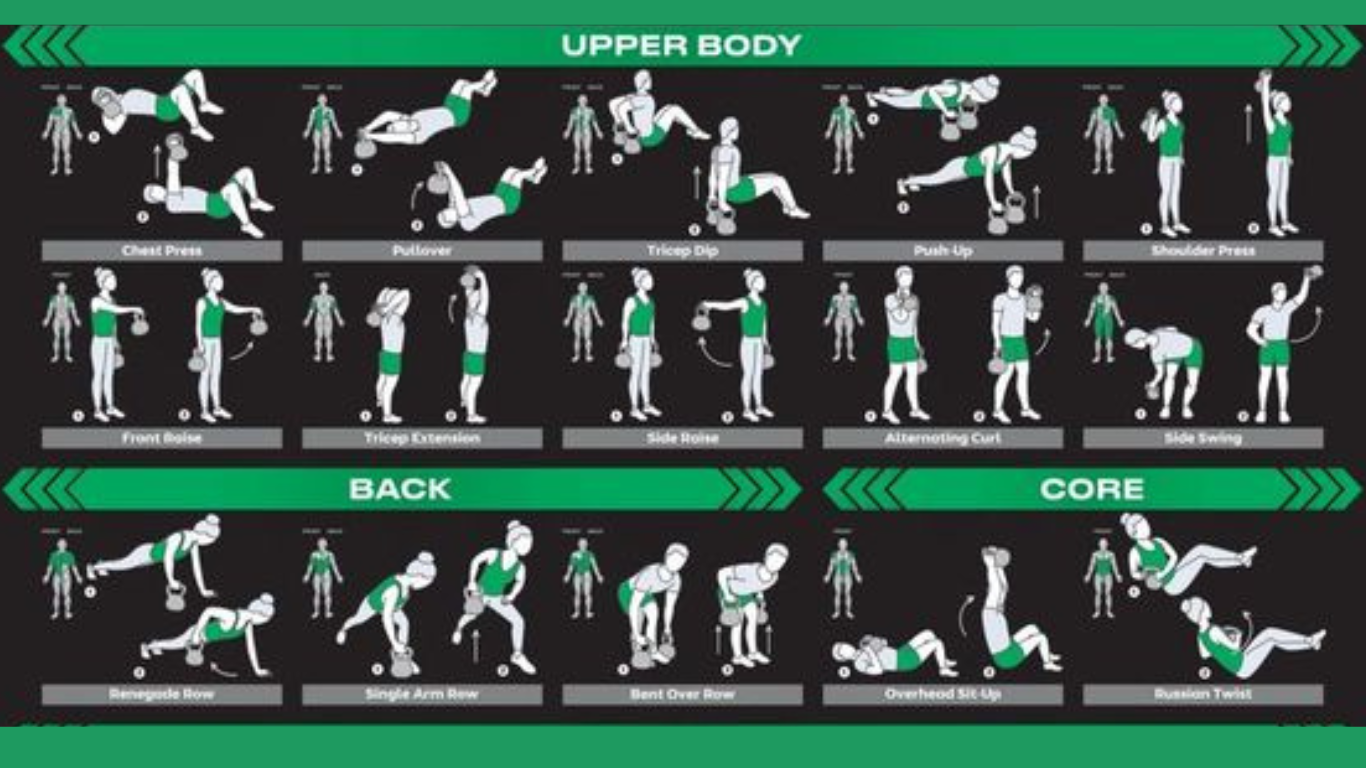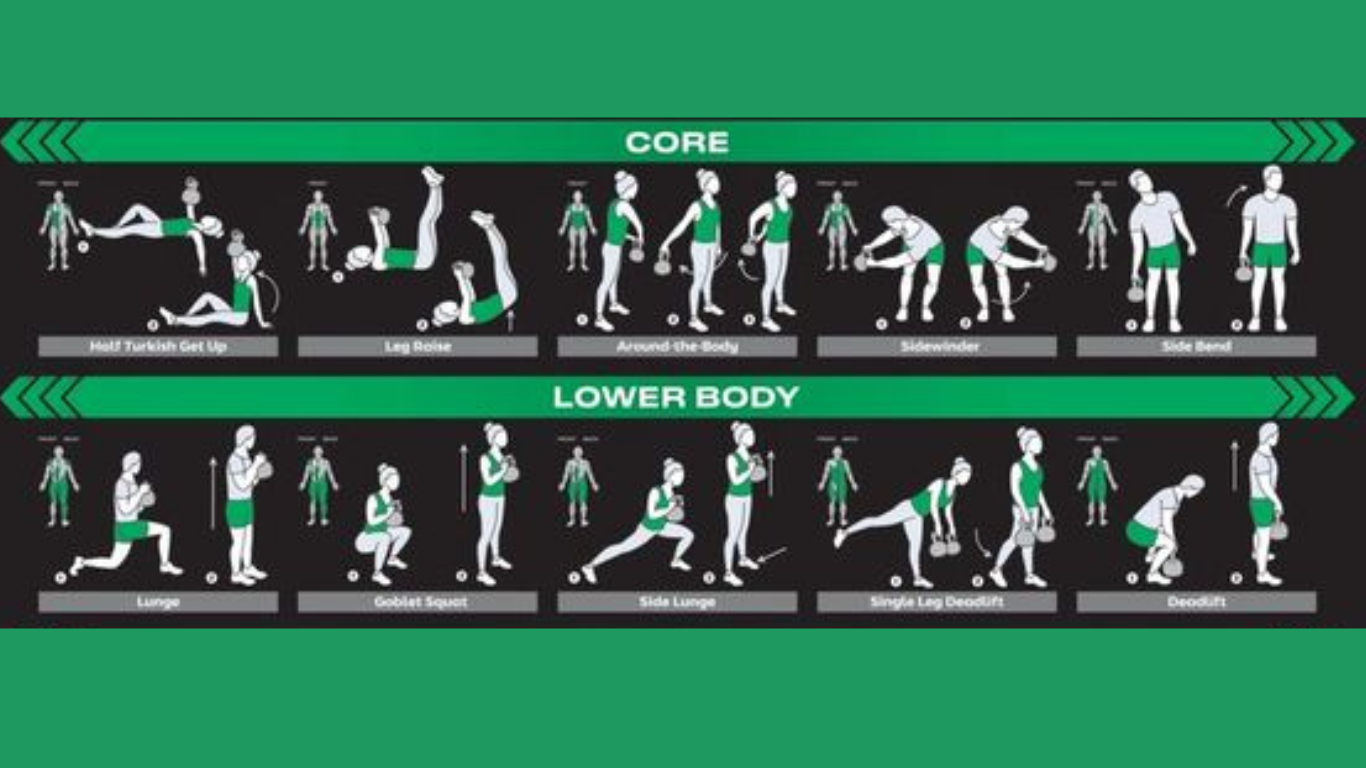Kettlebell Training Program: An Essential Guide to Effective Workouts
In this article, we will guide you through crafting the perfect Kettlebell Training Program, showing you how to design a dynamic fitness routine that maximizes strength, boosts endurance, and transforms your workout experience.
Have you ever tried lifting a kettlebell? The first time I did, I was surprised by how deceptively heavy it felt. That initial lift was a moment of realization—kettlebell training isn’t just another workout; it’s a complete fitness regimen that engages multiple muscle groups in a single motion. Whether you’re a seasoned athlete or a beginner looking to shake up your routine, kettlebell training program offers a versatile and efficient way to build strength and endurance.
Kettlebell training has gained popularity for its ability to deliver results in a short amount of time. Unlike traditional weightlifting, which often isolates muscles, kettlebell exercises involve dynamic movements that integrate various muscle groups simultaneously. This holistic approach not only improves strength but also enhances coordination and flexibility.
The benefits of kettlebell training extend beyond physical improvements. It’s a time-efficient workout that can be done almost anywhere, making it ideal for those with busy schedules. Moreover, the cardiovascular benefits of kettlebell exercises help improve heart health and stamina, contributing to overall fitness levels.

In this article, we’ll delve into how you can create your own kettlebell training program tailored to your fitness goals. Whether you aim to lose weight, gain muscle, or improve your athletic performance, designing a structured kettlebell routine can help you achieve these objectives effectively.
Creating an effective kettlebell training program starts with understanding your fitness goals. Are you looking to build strength, improve endurance, or enhance flexibility? Identifying your objectives will guide the selection of exercises and the intensity of your workouts. Each session should be structured to challenge your body while allowing for adequate recovery.
When designing your kettlebell training program, focus on incorporating a variety of exercises that target different muscle groups. Swings, snatches, cleans, and presses are fundamental movements that form the core of many kettlebell routines. These exercises not only build strength but also improve coordination and stability.
It’s essential to pay attention to proper form and technique when performing kettlebell exercises. Since many movements involve swinging or lifting the kettlebell above the head, maintaining control and stability is crucial to prevent injury. Start with lighter weights and gradually increase as you become more comfortable with the movements.
Subscribe And Get Our Free E-Book:Unlocking The Power Of Nutrition-Supplements, Substitutes, and Superfoods!
In addition to strength training, consider integrating cardiovascular exercises into your kettlebell training . High-intensity intervals, such as kettlebell swings or snatches performed in quick succession, can elevate your heart rate and burn calories effectively. This dual approach not only promotes fat loss but also enhances overall cardiovascular health.
Consistency is key to seeing results from your kettlebell training . Aim for regular workouts that challenge your body and progressively increase in intensity. Listen to your body and allow for adequate rest between sessions to prevent overtraining and promote recovery.
Kettlebell training offers a comprehensive and efficient way to achieve your fitness goals. By incorporating a variety of exercises that target different muscle groups, focusing on proper form, and maintaining consistency, you can create a personalized workout regimen that delivers results. Stay tuned for the next part of this series, where we’ll explore advanced techniques and tips to further enhance your kettlebell training program. Remember, with dedication and effort, you can harness the power of kettlebells to transform your fitness journey.
Understanding the Fundamentals
To understand the essence of kettlebell training program, it’s essential to delve into what kettlebell training truly entails and how it has evolved into a staple of modern fitness routines. Originating in Russia during the 18th century, kettlebells were originally used as counterweights in market stalls. Over time, their utility expanded to physical training and athletic conditioning, where their unique shape and handle allowed for dynamic movements that engaged multiple muscle groups simultaneously.

What sets kettlebells apart as effective tools for strength, endurance, and flexibility is their design and the range of exercises they facilitate. Unlike traditional free weights, such as dumbbells or barbells, kettlebells have a displaced center of mass, requiring constant stabilization during exercises. This instability not only enhances core strength but also improves overall balance and coordination—a crucial aspect when crafting your personalized kettlebell training program.
When incorporating kettlebell exercises into your fitness regimen, the emphasis is not solely on isolated muscle groups but on functional movements that mimic real-life activities. Movements like the kettlebell swing, snatch, and clean engage multiple joints and muscles in coordinated efforts, promoting functional strength that translates into everyday tasks and athletic performance.
The versatility of kettlebell exercises further enhances their appeal for creating a personalized kettlebell training program. From beginner to advanced levels, kettlebell workouts can be tailored to individual fitness goals and abilities. Whether your objective is to build muscle, improve cardiovascular endurance, or enhance flexibility, there’s a kettlebell exercise suitable for every stage of your fitness journey.
Moreover, kettlebells allow for seamless integration of different training modalities within a single workout session. By combining strength exercises with cardiovascular intervals, such as swings or high pulls, you can maximize calorie burn while improving muscular endurance—a dual benefit that supports comprehensive fitness development.
The beauty of kettlebell training lies in its accessibility and efficiency. Unlike elaborate gym equipment, kettlebells are compact and portable, making them perfect for home workouts or outdoor training sessions. This accessibility ensures consistency in your training, a key factor in achieving long-term fitness goals.
As you embark on creating your own kettlebell training program, understanding the origins and effectiveness of kettlebell training becomes pivotal. The historical roots of kettlebells as tools for strength and conditioning underscore their timeless appeal in modern fitness contexts. By harnessing their unique design and benefits, you can build a program that not only enhances physical performance but also fosters a deeper understanding of functional fitness principles.
Embracing kettlebell training means embracing a versatile and effective approach to fitness. From its humble beginnings in Russian markets to its widespread adoption in global fitness communities, kettlebells offer a pathway to strength, endurance, and flexibility that is both challenging and rewarding. Stay tuned for the next part of this series, where we’ll explore practical steps to designing and implementing your personalized kettlebell training program. Remember, with commitment and knowledge, you can leverage the power of kettlebells to transform your fitness journey.
Kettlebell Training Program: Exploring Practical Benefits
When it comes to designing your own kettlebell training program, understanding the practical benefits of this versatile workout tool is key. Unlike traditional exercises, kettlebell training offers a unique blend of efficiency and effectiveness that can transform your fitness routine.
Firstly, one of the standout advantages of kettlebell exercises is their ability to provide a comprehensive full-body workout. Take the kettlebell swing, for instance. This exercise not only targets your hips, glutes, and core but also engages your shoulders, back, and legs—all in one fluid motion. By incorporating such compound movements into your routine, you maximize your workout time and ensure that every muscle group is effectively challenged, laying a solid foundation for a balanced kettlebell training program.

Functional strength is another area where kettlebell training shines. Consider the kettlebell clean and press. This exercise not only builds strength in your upper body and core but also enhances your ability to lift and maneuver objects in real-life situations. Whether you’re lifting groceries or moving furniture, the functional strength gained from kettlebell exercises directly translates into practical everyday tasks, making it a valuable addition to any kettlebell training program aimed at improving overall physical capability.
Calorie burning during kettlebell workouts is impressive due to their high-intensity nature. For example, a circuit combining kettlebell swings with burpees can elevate your heart rate and torch calories effectively. Integrating such cardiovascular intervals not only aids in weight management but also enhances your overall fitness level—a crucial aspect to consider when structuring a kettlebell training program that promotes both health and performance.
Posture and joint stability are often overlooked but essential benefits of kettlebell training. Exercises like the Turkish get-up require precise movements that strengthen core stability and improve alignment, promoting better posture and reducing the risk of injury. Incorporating these exercises into your kettlebell training program helps maintain optimal joint health and supports long-term physical well-being.
Flexibility gains from kettlebell exercises are another practical advantage. Movements such as the kettlebell windmill or figure-eight not only enhance flexibility but also improve range of motion in joints like the hips and shoulders. These benefits are invaluable for maintaining mobility and preventing injuries as you age, making flexibility training a crucial component of any well-rounded kettlebell training program.
The practical benefits of kettlebell training program make it an ideal choice for anyone looking to create a versatile and effective fitness regimen. By integrating exercises that provide a full-body workout, enhance functional strength, promote calorie burning, improve posture and joint stability, and increase flexibility, you can design a personalized kettlebell training program tailored to your specific fitness goals. Stay tuned for the next part of this series, where we’ll delve into practical tips for structuring and implementing your kettlebell training program, ensuring you get the most out of this dynamic fitness tool.
Getting Started with Confidence! Lets create this program!
Starting your kettlebell training program involves two critical steps: selecting the right kettlebell weight and mastering safety precautions and proper form. These foundational elements are essential for beginners to ensure effective workouts and minimize the risk of injury, setting the stage for a successful fitness journey with kettlebells.
Selecting the Right Kettlebell Weight
Choosing the correct kettlebell weight is crucial for beginners to build strength and confidence without compromising form. Here’s how to determine the right weight:
- Start Light: For men, begin with a kettlebell weight between 12-16 kilograms (26-35 pounds). Women can start lighter, around 8-12 kilograms (18-26 pounds). These weights provide enough resistance to challenge your muscles without overwhelming them.
- Assess Your Strength: Consider your current fitness level and experience with weightlifting. If you’re unsure, err on the lighter side initially. You can always increase the weight as you become more comfortable with the exercises.
- Focus on Technique: The goal is to maintain proper form throughout each exercise. If you find yourself struggling to control the kettlebell or compromising your posture, it may be a sign that the weight is too heavy.
For example, if you’re new to kettlebell training and aiming to improve your strength and endurance, starting with a lighter kettlebell allows you to focus on mastering fundamental movements like the kettlebell swing or goblet squat. These exercises engage multiple muscle groups and provide a solid foundation for building a personalized kettlebell training program.

Safety Precautions and Proper Form
Mastering proper technique is essential to prevent injuries and optimize the benefits of kettlebell training. Here are practical safety tips and form guidelines to follow:
- Stance and Core Engagement: Begin each exercise with your feet hip-width apart, toes pointed slightly outward. Engage your core muscles to stabilize your spine and maintain balance throughout the movement.
- Spinal Alignment: Keep your spine neutral throughout the exercise. Avoid rounding your back or overarching, which can strain your spine and lead to discomfort or injury.
- Hip-Driven Movement: Many kettlebell exercises, such as the kettlebell swing or snatch, require power from your hips and legs rather than your arms. Initiate the movement by hinging at your hips and driving through with your glutes and hamstrings.
For instance, during a kettlebell swing, focus on driving your hips forward to propel the kettlebell upward, rather than using your arms to lift it. This technique not only maximizes the effectiveness of the exercise but also reduces the strain on your upper body.
- Breathing Technique: Coordinate your breathing with each movement. Inhale deeply during the eccentric phase (e.g., lowering the kettlebell) and exhale forcefully during the concentric phase (e.g., lifting or swinging the kettlebell). This breathing pattern helps stabilize your core and enhances overall performance.
- Progress Gradually: As your form improves and you feel more comfortable with the exercises, gradually increase the weight of the kettlebell. This progressive approach challenges your muscles while ensuring that you maintain control and proper technique throughout your kettlebell training program.
For example, once you’ve mastered the basic kettlebell swing with a lighter weight, you can progress to a heavier kettlebell to continue challenging your strength and endurance effectively.
- Seek Expert Guidance: If you’re new to kettlebell training or unsure about proper form, consider working with a certified kettlebell instructor or personal trainer. They can provide personalized feedback and corrections to help you optimize your technique and avoid common pitfalls.
By focusing on selecting the right kettlebell weight and mastering safety precautions and proper form, you establish a solid foundation for your kettlebell training program. These practical tips not only enhance your workout effectiveness but also promote injury prevention and long-term success in achieving your fitness goals with kettlebells. Stay tuned for the next part of this series, where we’ll explore essential kettlebell exercises and routines to incorporate into your personalized kettlebell training program. Remember, consistency and correct technique are key to maximizing the benefits of kettlebell training for your overall health and well-being.
Components of a Well-Rounded Kettlebell Program
Creating a well-rounded kettlebell training program involves understanding and incorporating essential components that maximize effectiveness and minimize the risk of injury. From warming up properly to selecting key exercises and implementing sound programming principles, each component plays a crucial role in achieving your fitness goals with kettlebells.
Warm-up: Importance of Warming Up and Dynamic Stretching
A proper warm-up is vital before engaging in any kettlebell training program. It prepares your body for exercise by increasing blood flow to your muscles, raising your heart rate gradually, and enhancing joint mobility. Dynamic stretching, in particular, helps improve flexibility and range of motion while activating muscles that will be used during your workout.
For example, before starting your kettlebell session, include dynamic movements like leg swings, arm circles, and hip rotations. These exercises help loosen tight muscles and joints, reducing the risk of injury during more intense kettlebell exercises such as swings, Turkish get-ups, and cleans.
Main Exercises: Key Kettlebell Exercises and Their Benefits
Incorporating key kettlebell exercises forms the core of your kettlebell training program. These exercises are chosen for their ability to target multiple muscle groups, improve functional strength, and enhance cardiovascular fitness.
- Kettlebell Swings: A dynamic movement that primarily targets the posterior chain—glutes, hamstrings, and lower back. It also engages the core and shoulders, making it an excellent exercise for developing power and explosive strength.
- Turkish Get-Ups: A complex movement that involves multiple joints and muscles working together to lift a kettlebell from lying to standing position. It improves stability, coordination, and overall body strength.
- Kettlebell Cleans: Focuses on explosive power and coordination as you lift the kettlebell from the floor to the rack position. It strengthens the upper body, particularly the shoulders, while challenging core stability and control.
For instance, structuring your kettlebell training program might involve starting with swings for power and cardiovascular conditioning, followed by Turkish get-ups for full-body strength and stability, and concluding with cleans to further enhance upper body strength and coordination.
Programming Principles: Progressive Overload, Variation, and Recovery
Effective programming principles ensure continuous progress and prevent plateaus in your kettlebell training program.
- Progressive Overload: Gradually increasing the demands placed on your muscles over time by adjusting weight, repetitions, or intensity. For example, start with a lighter kettlebell and gradually increase the weight as your strength improves to keep challenging your muscles.
- Variation: Incorporating a variety of exercises and workout formats to target different muscle groups and prevent monotony. For instance, alternate between heavy swings for strength and endurance and lighter Turkish get-ups for stability and coordination.
- Recovery: Allowing adequate rest and recovery between workouts to optimize muscle repair and growth. Recovery strategies include proper nutrition, hydration, sleep, and active rest days to prevent overtraining and injury.
For example, if your goal is to improve overall strength and endurance, you might structure your weekly kettlebell training program to include two days of heavy swings for strength, one day of Turkish get-ups for stability, and one day of cleans for power. This variation ensures balanced development across all fitness components while allowing for adequate recovery between sessions.

Kettlebell Exercise Benefits and Targeted Muscle Groups Chart
| Exercise | Primary Muscles Targeted | Secondary Muscles Targeted | Key Benefits |
|---|---|---|---|
| Kettlebell Swing | Glutes, Hamstrings, Core | Shoulders, Back | Improves explosive power, cardio fitness, and posterior chain strength |
| Turkish Get-Up | Core, Shoulders, Hips | Triceps, Back, Legs | Enhances full-body stability, coordination, and mobility |
| Kettlebell Clean | Shoulders, Back, Core | Biceps, Forearms | Develops explosive power, coordination, and upper body strength |
| Kettlebell Snatch | Shoulders, Back, Core | Glutes, Hamstrings | Builds explosive strength, endurance, and full-body coordination |
| Goblet Squat | Quadriceps, Glutes, Core | Hamstrings, Calves | Strengthens lower body, enhances core stability, and improves squat form |
| Kettlebell Press | Shoulders, Triceps, Core | Upper Chest | Increases shoulder strength, stability, and upper body endurance |
| Kettlebell Deadlift | Glutes, Hamstrings, Lower Back | Core, Forearms | Strengthens posterior chain, enhances core stability, and improves deadlift technique |
| Kettlebell Windmill | Shoulders, Core, Hips | Glutes, Hamstrings, Back | Enhances flexibility, core strength, and shoulder stability |
Visualization of Exercise Distribution
Here’s a pie chart showing the distribution of primary muscle groups targeted by these key kettlebell exercises:

Additional Insights
- Explosive Power and Cardiovascular Health:
- Kettlebell Swing and Snatch are excellent for building explosive power and improving cardiovascular health due to their dynamic nature.
- Full-Body Coordination and Stability:
- Turkish Get-Up and Windmill focus on full-body coordination and stability, crucial for injury prevention and functional fitness.
- Upper Body Strength:
- Kettlebell Press and Clean target the upper body, enhancing strength and endurance in the shoulders and arms.
- Lower Body Strength and Mobility:
- Goblet Squat and Deadlift are key for building lower body strength and improving mobility and stability.

In conclusion, a well-rounded kettlebell training program integrates warm-up protocols to prepare the body for exercise, key kettlebell exercises to target multiple muscle groups effectively, and programming principles like progressive overload, variation, and recovery to optimize performance and prevent injury. By understanding these components and applying them strategically, you can create a personalized kettlebell training program that supports your fitness goals and promotes long-term success. Stay tuned for the next part of this series, where we’ll delve into advanced techniques and tips to further enhance your kettlebell training program. Remember, consistency and smart programming are key to achieving your desired outcomes with kettlebell training.
Kettlebell Training Program: Crafting Your Personal Fitness Journey
Designing your own kettlebell training program is an empowering process that begins with setting clear goals, understanding programming variables, and implementing structured workout routines. By following these steps, you can create a personalized regimen that aligns with your fitness aspirations and promotes continuous progress.
Setting Goals: How to Establish SMART Goals
Setting specific, measurable, achievable, relevant, and time-bound (SMART) goals is crucial for guiding your kettlebell training program effectively.
- Specific: Clearly define what you want to achieve with your kettlebell workouts. For example, aim to improve strength, lose weight, or enhance endurance.
- Measurable: Establish metrics to track your progress. This could include increasing the weight lifted, reducing workout duration, or achieving a certain number of repetitions.
- Achievable: Set goals that are realistic and within your current capabilities. Consider your fitness level, schedule, and commitment to ensure success.
- Relevant: Ensure your goals align with your overall fitness objectives and personal interests. Tailor your kettlebell training program to suit your needs and preferences.
- Time-bound: Set a timeline for achieving each goal. Whether it’s weekly, monthly, or long-term goals, having deadlines creates accountability and motivation.
For example, if your goal is to improve strength with kettlebells, you might set a SMART goal to increase your kettlebell swing weight by 5 kilograms within the next 8 weeks.
Programming Variables: Intensity, Volume, Frequency, and Exercise Selection
Understanding programming variables allows you to manipulate key aspects of your kettlebell training program to achieve specific outcomes.
- Intensity: Refers to the level of effort exerted during each workout. Adjust intensity by varying kettlebell weight, repetitions, or rest periods between sets.
- Volume: Represents the total amount of work performed in a single session or over a period. Increase volume by adding more sets, repetitions, or exercises to your workouts.
- Frequency: Refers to how often you perform your kettlebell workouts per week. Balance frequency to allow adequate recovery while maintaining consistency.
- Exercise Selection: Choose exercises that align with your goals and target desired muscle groups. Include a mix of swings, Turkish get-ups, cleans, and other variations to keep your kettlebell training program diverse and effective.
For instance, an intermediate program may involve performing swings for power and conditioning three times a week, complemented by Turkish get-ups twice a week for stability and core strength.
Sample Programs: Example Workouts to Get Started
Here are examples of beginner, intermediate, and advanced kettlebell training programs to inspire your journey:
- Beginner Program:
- Day 1: 10 minutes of kettlebell swings (3 sets of 10 repetitions)
- Day 2: 15 minutes of Turkish get-ups (2 sets of 5 repetitions per side)
- Day 3: Rest or light activity
- Day 4: 12 minutes of swings and cleans (alternating sets, 3 sets of 8 repetitions each)
- Day 5: 10 minutes of kettlebell squats (3 sets of 12 repetitions)
- Intermediate Program:
- Day 1: 20 minutes of swings and snatches (4 sets of 10 repetitions each)
- Day 2: 15 minutes of Turkish get-ups (3 sets of 5 repetitions per side)
- Day 3: Rest or light activity
- Day 4: 25 minutes of cleans and presses (5 sets of 6 repetitions each)
- Day 5: 20 minutes of swings and lunges (alternating sets, 4 sets of 12 repetitions each)
- Advanced Program:
- Day 1: 30 minutes of complexes (5 sets of 8 repetitions)
- Day 2: 20 minutes of Turkish get-ups and windmills (3 sets of 5 repetitions each)
- Day 3: Rest or light activity
- Day 4: 40 minutes of kettlebell flows (6 sets of 10 repetitions)
- Day 5: 30 minutes of snatches and overhead squats (alternating sets, 5 sets of 6 repetitions each)
These sample programs illustrate how you can structure your kettlebell training program based on your fitness level and goals. Adjust the intensity, volume, frequency, and exercise selection as needed to create a program that challenges you while accommodating your individual capabilities and preferences.
Designing a kettlebell training program involves setting SMART goals, manipulating programming variables such as intensity and volume, and implementing structured workout routines that include a variety of key kettlebell exercises. By following these guidelines and exploring sample programs, you can create a personalized fitness regimen that supports your journey towards improved strength, endurance, and overall fitness with kettlebells. Stay tuned for more insights and tips to optimize your kettlebell training program and achieve your fitness aspirations effectively and sustainably.
Common Mistakes to Avoid When Creating Your Program
Embarking on your journey with a kettlebell training program can be highly rewarding, but it’s essential to navigate common pitfalls that beginners often encounter. By understanding these challenges and implementing strategies to overcome them, you can optimize your workouts and stay motivated towards achieving your fitness goals effectively.
Common Mistakes to Avoid
- Using Improper Form: One of the most common mistakes beginners make in kettlebell training programs is using improper form. Incorrect technique not only reduces the effectiveness of exercises but also increases the risk of injury. For example, swinging the kettlebell with rounded shoulders or arching the back during Turkish get-ups can strain muscles and joints.
- Lifting Too Heavy Too Soon: Another mistake is lifting weights that are too heavy before mastering proper form and technique. This can lead to muscle strain, overexertion, and potential injuries. It’s crucial to start with a manageable weight and gradually increase as your strength and proficiency improve.
- Neglecting Warm-up and Cool-down: Skipping warm-up exercises and cool-down stretches is a common error that can hinder performance and recovery. Proper warm-up prepares your muscles and joints for exercise, while cool-down helps reduce muscle soreness and promotes flexibility.
- Overtraining: Pushing yourself too hard without allowing adequate rest and recovery can lead to burnout and overtraining syndrome. Rest days are essential for muscle repair and growth, so incorporate them into your kettlebell training program to prevent fatigue and optimize results.
Tips to Overcome These Mistakes
- Focus on Technique: Prioritize mastering proper form and technique from the beginning of your kettlebell training program. Start with lighter weights to ensure you can perform exercises correctly before progressing to heavier loads. Consider working with a certified trainer initially to learn correct techniques and receive feedback.
- Gradual Progression: Adopt a gradual approach to weight and intensity progression. Increase weights and repetitions gradually as you become more comfortable and proficient with exercises. Listen to your body and avoid the temptation to lift heavier weights prematurely.
- Include Warm-up and Cool-down: Dedicate time to warm-up exercises such as dynamic stretches and movements that mimic kettlebell exercises. Likewise, incorporate static stretches and foam rolling during cool-down to aid muscle recovery and flexibility.
- Rest and Recovery: Schedule regular rest days in your kettlebell training program to allow your muscles to recover and repair. Active recovery activities such as yoga, swimming, or light walking can help maintain mobility and circulation without taxing your muscles.
Staying Motivated
Maintaining motivation is key to sustaining a kettlebell training program long-term. Here are strategies to stay inspired and committed:
- Set Realistic Goals: Establish achievable short-term and long-term goals that align with your fitness aspirations. Celebrate milestones along the way to stay motivated and track progress.
- Variety in Workouts: Keep your kettlebell training program engaging by incorporating a variety of exercises and workout formats. Experiment with different kettlebell movements, circuits, and challenges to keep workouts fresh and enjoyable.
- Find a Workout Partner or Community: Joining a fitness class, group, or finding a workout partner can provide accountability and support. Sharing experiences and progress with others can boost motivation and make exercising more enjoyable.
- Track Your Progress: Keep a workout journal or use fitness apps to track workouts, weights lifted, and improvements in performance. Seeing tangible progress can reinforce your commitment and inspire you to continue challenging yourself.
Avoid These Mistakes in Kettlebell Swings Video
By recognizing and avoiding common mistakes in kettlebell training programs, and implementing strategies to stay motivated, you can enhance your fitness journey and achieve sustainable results. Remember, consistency, proper technique, and a balanced approach to progression are key to maximizing the benefits of kettlebell training for your overall health and well-being. Stay committed to your goals, stay safe, and enjoy the transformative power of kettlebell workouts in your fitness routine.
Incorporating Kettlebells into Your Routine
Incorporating kettlebell training into your fitness regimen can significantly elevate your overall workout effectiveness by integrating dynamic movements that target multiple muscle groups simultaneously. Whether you’re looking to enhance strength, improve cardiovascular endurance, or increase flexibility, kettlebells offer versatile benefits that complement various forms of exercise. Here’s how you can seamlessly integrate kettlebell workouts into your weekly schedule and maximize their impact alongside other fitness activities.
Complementing Other Forms of Exercise
Kettlebell training serves as an excellent complement to a wide range of exercises, including cardio, yoga, and weightlifting. Its unique combination of strength and cardiovascular benefits makes it a valuable addition to any fitness routine.
- Cardiovascular Exercise: Incorporating kettlebell swings, snatches, or complexes into your cardio sessions can elevate heart rate and calorie burn while building muscular endurance. These movements engage large muscle groups like the glutes, hamstrings, and core, enhancing overall cardiovascular fitness.
- Yoga: Integrating kettlebell flows or Turkish get-ups into yoga routines can add a strength and stability component to your practice. Kettlebell exercises challenge balance, coordination, and functional mobility, complementing the flexibility and mindfulness aspects of yoga.
- Weightlifting: Kettlebell training provides an alternative to traditional weightlifting exercises by incorporating dynamic movements that improve power, explosiveness, and muscular endurance. Exercises such as cleans, presses, and lunges with kettlebells offer functional strength benefits that can enhance traditional weightlifting routines.
By incorporating kettlebell training alongside these forms of exercise, you can create a well-rounded fitness program that promotes overall strength, cardiovascular health, flexibility, and functional movement patterns.
Integrating Kettlebell Workouts into Your Weekly Schedule
Effectively integrating kettlebell workouts into your weekly schedule requires thoughtful planning to ensure balanced training and adequate recovery. Consider the following tips to optimize your kettlebell training program:
- Set Clear Objectives: Determine specific goals for incorporating kettlebell workouts into your routine, such as improving strength, increasing endurance, or enhancing overall fitness. Align your weekly schedule with these objectives to focus on relevant kettlebell exercises.
- Balance Frequency and Intensity: Plan your kettlebell training sessions throughout the week to allow for sufficient recovery between workouts. Aim for 2-4 sessions per week, depending on your fitness level and goals. Mix high-intensity sessions with lighter recovery-focused workouts to prevent overtraining and promote optimal performance.
- Integrate with Existing Workouts: Identify opportunities to integrate kettlebell exercises with your existing workout routines. For example, perform kettlebell swings or cleans before or after your cardio sessions to maximize calorie burn and muscle engagement. Alternatively, incorporate kettlebell circuits into circuit training or HIIT workouts for added variety and challenge.
- Progressive Overload: Gradually increase the intensity, duration, or complexity of your kettlebell workouts over time to continuously challenge your muscles and prevent plateauing. Incorporate different kettlebell weights and variations to target various muscle groups and keep your workouts dynamic and engaging.
- Recovery and Rest: Prioritize rest days and active recovery to allow your muscles to recover and adapt to the demands of kettlebell training. Adequate sleep, hydration, and nutrition are essential for supporting muscle repair and overall recovery.
By strategically incorporating kettlebell training into your weekly schedule and balancing it with other forms of exercise, you can enhance your overall fitness, strength, and endurance. Whether you’re a beginner or an experienced fitness enthusiast, kettlebells offer versatile training options that can be tailored to your specific goals and preferences.
In conclusion, integrating kettlebell workouts into your fitness routine provides numerous benefits that complement other forms of exercise, including cardio, yoga, and weightlifting. By following these tips and incorporating kettlebell training strategically into your weekly schedule, you can maximize your workout efficiency, achieve your fitness goals, and enjoy the diverse benefits of kettlebell exercises. Stay committed to your fitness journey, explore different kettlebell exercises, and discover how they can transform your overall health and well-being.
Kettlebell Training Program: Mastering Advanced Techniques and Progression
For those eager to elevate their kettlebell training program to the next level, mastering advanced techniques and progression strategies is key to achieving greater strength, endurance, and overall fitness. By incorporating complex kettlebell movements and leveraging progressive methods, you can continue challenging your body while expanding your skill set in kettlebell training.
Advanced Techniques and Progression
Advanced kettlebell techniques involve intricate movements that require mastery of fundamental skills and enhanced coordination. These techniques not only intensify workouts but also target specific muscle groups with precision and efficiency.
- Double Kettlebell Exercises: Incorporating two kettlebells simultaneously in exercises such as double kettlebell swings, snatches, and cleans challenges stability, coordination, and core strength. These exercises increase overall workload and engage a broader range of muscles, promoting balanced development.
- Complex Movements: Advanced kettlebell flows and complexes combine multiple exercises into seamless sequences that enhance cardiovascular endurance and muscular endurance. Movements like kettlebell juggling or flow patterns integrate transitions between exercises, requiring concentration and fluidity.
- Unilateral Movements: Single-arm kettlebell exercises such as single-arm swings, presses, and rows isolate each side of the body, improving balance and addressing strength imbalances. Unilateral training enhances functional strength and stability, making everyday movements more efficient.
Progression Strategies
Progressive training methods ensure continuous improvement and prevent plateauing in your kettlebell training program. Implementing structured progression allows you to challenge yourself while maintaining safety and efficiency in workouts.
- Gradual Weight Increase: Gradually increase kettlebell weight to progressively overload muscles and stimulate strength gains. Start with manageable weights and incrementally increase as you build confidence and proficiency in each exercise.
- Volume and Intensity: Manipulate workout volume (sets and repetitions) and intensity (weight and speed) to vary stimulus and optimize adaptation. Periodize training by alternating between high-intensity sessions and recovery-focused workouts to prevent overtraining.
- Skill Development: Dedicate time to refining technique and mastering advanced kettlebell movements. Focus on quality repetitions and fluid transitions between exercises to maximize effectiveness and minimize injury risk.
Resources for Further Learning
Exploring additional resources can deepen your understanding of kettlebell training and provide valuable insights into advanced techniques and programming strategies.
- Books: Books such as “Enter the Kettlebell!” by Pavel Tsatsouline and “Kettlebell Rx: The Complete Guide for Athletes and Coaches” by Jeff Martone offer comprehensive guides to kettlebell exercises, programming principles, and progression methods.
- Online Courses: Online platforms like Udemy, Coursera, and Kettlebell Kings Academy offer courses taught by certified trainers and experts in kettlebell training. These courses cover a range of topics from beginner basics to advanced techniques and program design.
- Certified Trainers: Working with a certified kettlebell trainer provides personalized instruction, feedback, and programming tailored to your fitness goals and abilities. Trainers can offer hands-on guidance, correct form errors, and customize workouts to challenge and support your progress.
By integrating advanced techniques and progressive strategies into your kettlebell training program, you can expand your fitness capabilities, achieve new milestones, and maintain long-term motivation. Whether you’re aiming to enhance strength, improve endurance, or refine technique, mastering advanced kettlebell movements offers a pathway to continuous growth and improvement in your fitness journey.
Explore various resources, seek expert guidance, and challenge yourself with advanced kettlebell techniques to unlock your full potential and experience the transformative benefits of kettlebell training. Embrace the journey of mastering complex movements, refining skills, and achieving peak performance with kettlebells as your versatile fitness companion.
Kettlebell Training Program: Embrace the Journey to Fitness Excellence
Throughout this comprehensive guide on kettlebell training, we’ve explored the multifaceted benefits and practical strategies to help you design a personalized workout program that suits your fitness goals and aspirations. Let’s recap the inspirational benefits of incorporating kettlebell workouts into your fitness routine, and encourage you to embark on your journey towards strength, endurance, and overall well-being.
- Total Body Engagement: Kettlebell exercises engage multiple muscle groups simultaneously, offering a holistic approach to fitness. Each swing, clean, or snatch activates core stability, strengthens limbs, and enhances overall muscular endurance. Embrace the efficiency of kettlebell training, where every movement contributes to your total-body strength and functionality.
- Functional Strength and Mobility: Unlike traditional weightlifting, kettlebell movements emphasize functional strength and mobility. By mimicking real-life movements such as lifting, twisting, and pulling, kettlebell training enhances your ability to perform daily tasks with ease and confidence. Rediscover the joy of movement through exercises that promote flexibility, coordination, and joint stability.
- Cardiovascular Endurance: Incorporating kettlebell swings and complexes into your routine elevates heart rate, promoting cardiovascular health and fat loss. Experience the dual benefits of strength training and aerobic exercise in one dynamic workout session. Enhance your stamina and resilience through kettlebell routines that challenge your cardiovascular system while building lean muscle mass.
- Versatility and Progression: From beginner basics to advanced techniques, kettlebell training offers endless possibilities for progression and growth. Start with foundational exercises, gradually increase weight and intensity, and explore complex movements to continuously challenge your body and mind. Embrace the journey of self-improvement and personal growth through the versatile nature of kettlebell workouts.
Now is the time to harness the transformative power of kettlebell training and start designing your own personalized program. Utilize the guidelines and principles shared throughout this guide to set specific goals, select appropriate exercises, and structure your weekly workouts for maximum effectiveness. Whether you’re aiming to build strength, enhance flexibility, or improve overall fitness, kettlebells provide a versatile tool to support your journey towards success.
Comparison of Kettlebell Training vs. Other Forms of Exercise Chart
| Feature/Benefit | Kettlebell Training | Traditional Weightlifting | Cardiovascular Exercise |
|---|---|---|---|
| Muscle Engagement | Full-body engagement | Targeted muscle groups | Primarily lower body and cardiovascular |
| Functional Strength | High – mimics real-life movements | Moderate – isolated movements | Low – minimal strength benefits |
| Cardiovascular Benefits | High – combines strength and cardio | Low – primarily strength-focused | Very High – primary focus |
| Calorie Burn | High – due to continuous movement | Moderate – depends on intensity | High – sustained aerobic activity |
| Flexibility and Mobility | High – dynamic and varied movements | Low – static movements | Moderate – depends on type (e.g., running vs. swimming) |
| Workout Duration | Short – efficient full-body workouts | Long – requires multiple exercises | Varies – typically longer sessions |
| Equipment Required | Minimal – a few kettlebells | High – various weights and machines | Minimal to moderate – varies by activity (e.g., running shoes vs. stationary bike) |
| Skill Development | High – requires learning and improving techniques | Moderate – technique is important | Low – straightforward movements |
| Adaptability | Very adaptable – can vary weight, intensity, and exercises | Adaptable – can increase weight and vary exercises | Adaptable – can change intensity and duration |
Summary
- Kettlebell Training: Offers a balanced approach with full-body muscle engagement, high cardiovascular benefits, and functional strength development in a short, efficient workout.
- Traditional Weightlifting: Focuses on isolated muscle groups with less cardiovascular benefit, requiring longer workouts and more equipment.
- Cardiovascular Exercise: Primarily enhances cardiovascular health and endurance, with less focus on muscle strength and functional movement.
As you embark on this exciting venture, we invite you to share your experiences, ask questions, and connect with like-minded individuals in the comments section below or through social media channels. Your journey with kettlebell training is unique, and we’re here to support and inspire you every step of the way. Together, let’s embrace the challenge, celebrate achievements, and empower each other towards a healthier, stronger future.
Embrace the kettlebell, design your path to fitness excellence, and discover the limitless possibilities of a kettlebell training program tailored to your goals and aspirations. Start today and redefine what’s possible for your body and mind.


